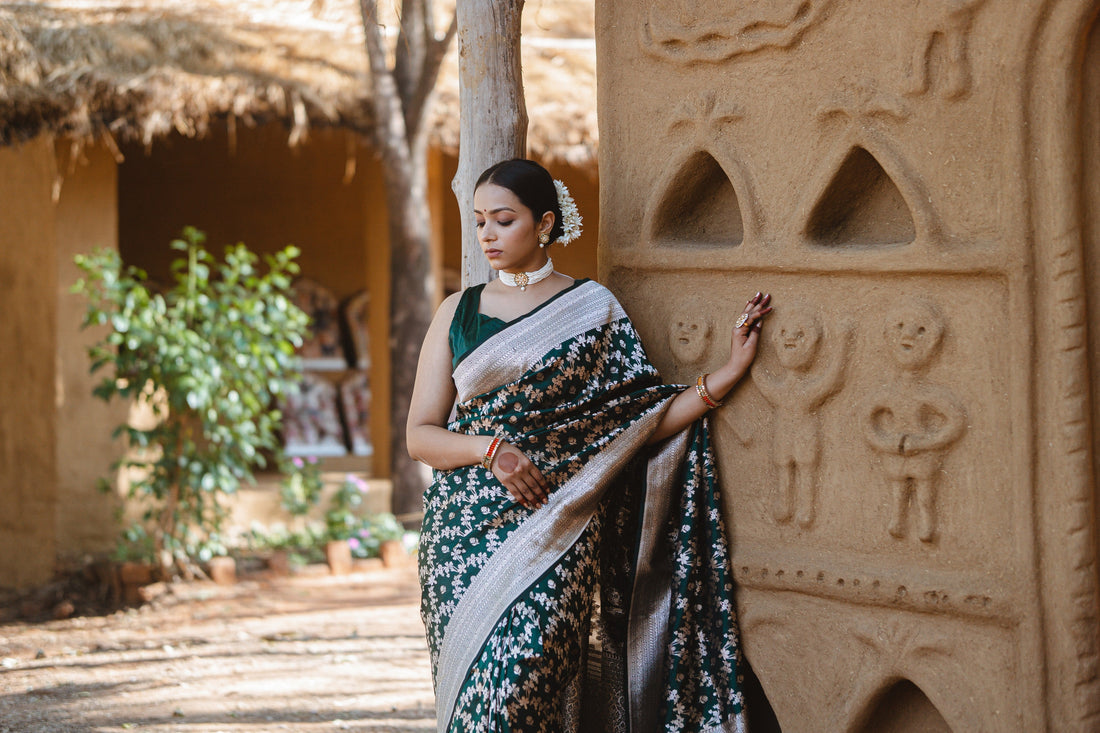
Saree Draping Styles from Different Indian States
India is a land of diverse cultures, and nothing reflects this better than the traditional saree draping styles found across the country. From the elegant folds of the Nivi drape in Andhra Pradesh to the regal charm of the Bengali style, each region boasts its own technique—highlighting the essence of handloom sarees, fabrics, and artisan craftsmanship. Whether you’re wearing a Banarasi silk saree, a Khandua silk, or a light and breezy organza saree, how you drape it tells a unique story.
In this blog, we take you on a beautiful journey through India’s iconic saree drapes, how they reflect local tradition, and how you can style handloom sarees from Atulya Karigari to honor these timeless looks.
1. Nivi Drape (Andhra Pradesh/Telangana)
This is the most common saree draping style seen across India. Originating in Andhra Pradesh, the Nivi style is timeless and versatile.
Features:
-
The pleats fall in front.
-
The pallu drapes over the left shoulder.
-
Perfect for all types of handloom sarees like georgette sarees, organza sarees, or even luxurious Banarasi silk sarees.
Styling Tip:
Pair with a contrasting blouse and a sleek belt for a modern twist.
2. Bengali Drape (West Bengal)
This is an elegant two-pleat drape, traditionally worn with handwoven cotton sarees or silk sarees like tissue sarees.
Features:
-
No pleats in the front.
-
The pallu is wrapped around the body and then thrown over the left shoulder.
-
Sometimes includes a key ring or bunch of keys tied to the edge of the pallu.
Best Paired With:
Khandua silk or light hand-painted sarees.
3. Maharashtrian Nauvari Drape
This 9-yard saree style is a bold and iconic drape that allows ease of movement.
Features:
-
Tucked between the legs like a dhoti.
-
Pallu is draped over the shoulder and often covers the head.
-
Ideal for Kota Doria sarees and tissue sarees with good stiffness.
Artisan Highlight:
Many handloom artisans from Maharashtra specialize in weaving bold borders and temple designs that complement this look.
4. Odia Khandua Drape (Odisha)
This draping style showcases the pride of Odisha—Khandua silk sarees, often paired with Pattachitra motifs and handwoven ikat designs.
Features:
-
Wide pleats at the front.
-
The pallu is brought over the shoulder and wrapped around the waist.
-
Often worn with traditional tribal jewelry.
5. Gujarati Seedha Pallu Drape
Popular in Gujarat and Rajasthan, this style displays the saree's intricate pallu in front.
Features:
-
Pleats in the front.
-
Pallu is draped over the right shoulder and brought forward.
Best With:
Banarasi silk sarees and tissue sarees, especially during weddings or festivals.
6. Kerala Mundum Neriyathum
This white and gold saree style, worn in Kerala, is a symbol of purity and elegance.
Features:
-
Traditionally two-piece.
-
Minimal pleats with a pallu over the left shoulder.
Works Well With:
Handloom cotton, golden grass accessories, and eco-friendly jewelry.
7. Madisar Drape (Tamil Nadu – Brahmin Style)
Worn by Tamil Brahmin women, this style uses a 9-yard saree and is tied similar to the Nauvari style.
Features:
-
One end is tucked at the back and wrapped between the legs.
-
The pallu is brought over the shoulder in a specific ritualistic style.
Ideal For:
Traditional handloom silk sarees, especially in wedding ceremonies.
Bringing Regional Styles to Your Wardrobe with Atulya Karigari
Whether you’re styling a Banarasi silk saree for a North Indian wedding, or choosing an organza saree for a summer brunch, Atulya Karigari offers a range of authentic, artisan-crafted handloom sarees and handicrafts that celebrate every regional identity.
Atulya Karigari supports rural artisans and traditional crafts such as:
-
Pattachitra paintings – perfect to pair as backdrops or blouses
-
Dhokra art – tribal brass jewelry to enhance saree looks
-
Sabai grass and golden grass – for natural accessories and bags
-
Hand-painted crafts – adding uniqueness to your ethnic ensemble
Why Embrace Regional Draping Styles?
-
Celebrate Cultural Heritage
-
Support Indian Artisans and Handloom Weavers
-
Style Uniquely for Every Occasion
-
Make Sustainable Fashion Choices
Final Words: Let Your Saree Tell a Story
Every time you wear a saree, you’re wearing history. By experimenting with traditional saree draping styles, you connect with India's diverse roots and empower the communities that preserve these art forms. Whether it's Khandua silk, Banarasi, or georgette sarees, make it meaningful. Make it Atulya.
Explore handcrafted sarees and artisan stories at Atulya Karigari.
